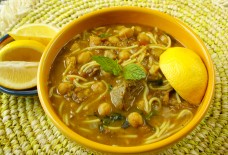Middle Eastern Meatballs: The Origin of the Globe Trotting Meatball
By: Blanche Shaheen/Arab America Contributing Writer
Italian polpettes, Chinese Wan Zi, Spanish Albondigas, Swedish meatballs, Middle Eastern kofta–which meatball came first? While Americans associate meatballs with Italy, believe it or not, the meatball originated from the Middle East! The word “kofta,” which has spelling variations in India, Turkey, Iran, and the Arab world, means “pounded meat” in Farsi. Food historians believe this beloved sphere of meat originated in the Persian empire, then spread along trade routes.
Today this multicultural staple takes on many creative forms all over the world, whether doused in sauce and served with noodles American style, served in a broth in Italian wedding soup, or stuffed with an egg in the United Kingdom. The meatball is basically a canvas for herbs and spices, aromatics, binders like eggs or breadcrumbs, and even dried fruits or nuts. Every single ingredient has interchangeable potential. Don’t like beef? Use ground turkey. Don’t like parsley? Use basil. Turn the meatballs into a vegan dish by substituting cooked lentils for the meat, as lentils grind up quite nicely in a food processor. However, to maintain the essence of the middle eastern meatball, the following recipe has onions and parsley, staples in any ground meat dish from this region.
What’s great about meatballs is they are hearty enough for adults, yet appealing and fun for children. I developed this middle eastern variation of meatballs for the Fancy Food Show in San Francisco, and while I churned out hundreds of meatballs a day, I could barely keep up with the demand. Even the intoxicating smell of these meatballs sent convention goers to my booth before they were even ready to serve! Once I returned home and made them for my family, my children were hooked, and they are now a staple in their weekly lunches. If you have children you can engage them in helping you roll the meatballs, which will encourage them to eat the finished product, since they feel a part of the cooking process.
These particular meatballs are emboldened with an ancient ingredient, black garlic. While the Chinese have been using this fermented black garlic for centuries, this ingredient is making a comeback in culinary circles. Because of the fermentation process, black garlic has twice the antioxidants of regular garlic and is powerful in fighting inflammation. The flavor of black garlic is rich but without the pungency. There are hints of caramel in black garlic, as well as a smooth creamy texture that compliments sauces and marinades. For this recipe, I brush the meatballs with a sauce containing pomegranate molasses and balsamic glaze. I find this glaze is a healthy substitute for barbeque sauce, which often contains high fructose corn syrup and artificial colors.
To see the video tutorial for this recipe, click on the video below:
Middle Eastern Meatballs
Ingredients:
Meatballs:
1 pound free-range organic ground beef (or lamb or turkey)
Handful of parsley
3 large cloves black garlic (or 4 small cloves regular garlic)
1 tsp allspice
⅓ cup breadcrumbs (can use gluten-free)
½ red onion
Salt and pepper to taste
Glaze
Pomegranate molasses glaze
¼ cup olive oil
1 tbsp pomegranate molasses
1 tbsp honey
1 tbsp balsamic glaze (see note)
In a food processor, whirl the garlic until finely chopped. Add the onion and mix again until the onions are finely chopped and incorporated with the garlic. (You can do this all by hand but the food processor expedites these steps tremendously) Add the parsley and whirl again until the parsley is finely chopped. In a large bowl, add the meat, breadcrumbs, allspice, salt, and pepper. Add the onion mixture to the meat mixture in the bowl, and mix until well incorporated by hand. This will prevent the meat from getting tough. Shape into meatballs, and pan fry in avocado or sunflower oil. Once the bottoms are nicely browned after about 3 minutes or so, flip each meatball over to brown the other side. Cover the pan, and continue to cook, covered, until the meatballs are just cooked through. Whirl all the glaze ingredients in another food processor, or whisk with a fork. Drizzle or brush the glaze onto the meatballs before serving.
Note: To make your own balsamic glaze, pour ½ cup balsamic vinegar into a saucepan, and add 1 tbsp of sugar. Boil, then reduce heat and simmer for 20 minutes. The vinegar should reduce by half. The glaze should coat the back of a spoon.
Blanche Shaheen is a journalist, food writer, and host of the cooking show called Feast in the Middle East. She specializes in Arab cuisine of the Levant and beyond You can check out her cooking video tutorials and cultural commentary on growing up Arab American at https://www.youtube.com/user/blanchetv Her recipes can also be found at: https://feastinthemiddleeast.wordpress.com/ and on Instagram on @Blanchemedia



